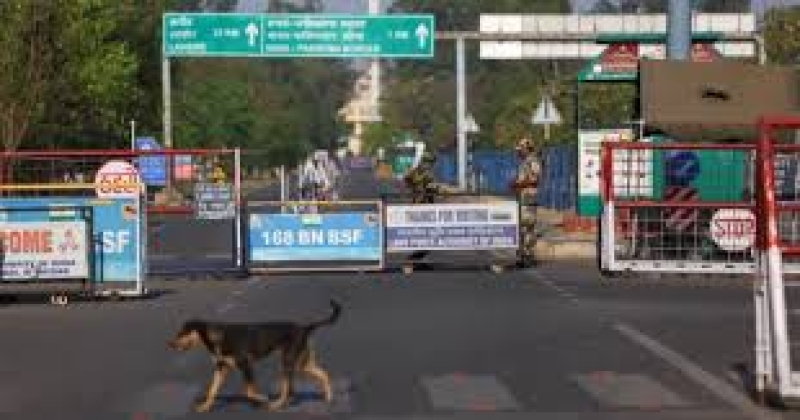- Intimidation or bloodshed cannot halt Bangladesh’s march to democracy |
- Khaleda Zia integral to an important chapter in BD history: Yunus |
- Enthusiasm marks Victory Day celebrations across Bangladesh |
- Dhaka-Delhi ties deep; to be shaped by trust, dignity, mutual respect |
- EU deploys election observation mission to Bangladesh |
India-Pakistan Trade Hidden From Official Records

In the aftermath of a deadly attack in Pahalgam, a scenic area of India-administered Kashmir that left at least 26 people dead, tensions between India and Pakistan escalated, prompting both nations to take retaliatory diplomatic steps, including halting cross-border trade and suspending visa services.
India blamed Pakistan for the April 22 assault, withdrew from a crucial water-sharing pact over the Indus River, and reduced its diplomatic presence in Islamabad. Pakistan rejected the allegations, demanded a neutral inquiry, and imposed a blanket suspension on trade with India — even via third countries. Trade ties between the two neighbours have been virtually frozen since 2019, and the Wagah-Attari land crossing, the primary official trade route, has also been sealed.
Despite the breakdown in formal trade, experts say the actual level of commerce between the two countries is significantly higher, driven by indirect routes that bypass official scrutiny.
Did India and Pakistan ever have robust trade relations?
Yes. Trade commenced soon after the 1947 partition of British India. In 1996, India granted Pakistan “Most Favoured Nation” (MFN) status under World Trade Organization rules, mandating equal treatment among trading partners. Still, political friction, particularly over Kashmir, prevented trade from reaching its full potential.
In the fiscal year 2017–18, official bilateral trade reached $2.41 billion, with India exporting $1.92 billion worth of goods and importing $488.5 million. However, after a deadly 2019 suicide bombing in Pulwama, India revoked Pakistan’s MFN status. By 2024, total trade had fallen to just $1.2 billion. Pakistan’s exports to India plunged from $547.5 million in 2019 to merely $480,000 by 2024.
What’s the current state of official trade?
Between April 2024 and January 2025, India’s exports to Pakistan stood at $447.7 million, while Pakistan’s exports totaled just $420,000, according to India’s Ministry of Commerce.
India primarily exports pharmaceuticals, petroleum products, rubber, plastics, organic chemicals, spices, dairy, and cereals. Pakistan’s main exports to India include copper, glassware, fruits, oilseeds, and sulphur.
Trade lawyer Shantanu Singh noted that Pakistan’s pharmaceutical sector, which depends heavily on Indian imports, is likely to be hit hardest. He also pointed out that closing the Wagah-Attari Integrated Check Post (ICP) — the sole operational land trade route — will increase logistical costs and affect regional trade, particularly with Afghanistan.
Is actual trade higher than reported?
Yes. While official data puts Indian exports to Pakistan at $447.7 million, estimates from the Global Trade Research Initiative (GTRI) suggest the real volume could be as high as $10 billion annually. This occurs through indirect channels, using countries like the UAE, Sri Lanka, and Singapore as intermediaries.
How does this backchannel trade operate?
According to GTRI founder Ajay Srivastava, Indian goods are first shipped to hubs like Dubai, Singapore, and Colombo. These goods are stored in bonded warehouses, where documents and origin labels are altered before being re-exported to Pakistan under a new country of origin.
Srivastava explained that while this "grey-zone" trade may not always be illegal, it enables commerce to continue discreetly and profitably despite official restrictions.
Is such trade common globally?
Yes. Similar tactics are used worldwide to sidestep trade restrictions. Economist Jayati Ghosh cited India as a key transshipment point for Russian oil heading to Europe since the Ukraine war. In 2023, India imported 1.75 million barrels per day of Russian crude — up 140% from 2022 — making up 40% of its total crude imports in 2024.
Likewise, economist Biswajit Dhar said China has long routed its exports to India via ASEAN countries to benefit from preferential trade terms, avoiding high tariffs that apply to direct Chinese imports.
Can informal India-Pakistan trade continue?
Efforts are underway in both countries to monitor and potentially curb this unofficial trade. Pakistan’s new ban includes third-country trade routes, and Indian authorities are collecting data on indirect exports.
However, enforcing these restrictions is challenging since private businesses — not governments — handle most of the rerouting and relabelling. Customs officials in Pakistan must determine whether imported goods truly originate from a listed third country or are merely Indian products disguised to bypass trade bans.
Singh noted that proving the origin requires importers to provide documentation under Pakistani law. He stressed that increased scrutiny of imports may be necessary.
Still, demand in Pakistan for Indian goods — especially given shared cultural preferences — ensures this trade is likely to persist. Higher margins and market demand incentivize traders to maintain indirect routes.
As Singh put it, “This trade will continue because the demand exists. Traders won’t willingly give up a profitable business.” Dhar added that unless traders cooperate fully — which is unlikely — enforcing trade bans may prove futile.
Have there been previous trade disruptions?
Yes. The 1965 war halted trade, but the Tashkent Agreement in 1966 gradually restored ties. The 1971 war — leading to Bangladesh’s independence — again strained relations. Although the 1972 Simla Agreement aimed to normalise ties, trade has remained volatile.
In 2019, after the Pulwama bombing, India imposed 200% import duties on Pakistani goods. Months later, it revoked Jammu and Kashmir’s special status, prompting Pakistan to downgrade diplomatic relations and suspend trade. Since then, no formal trade negotiations have resumed, reports UNB.

